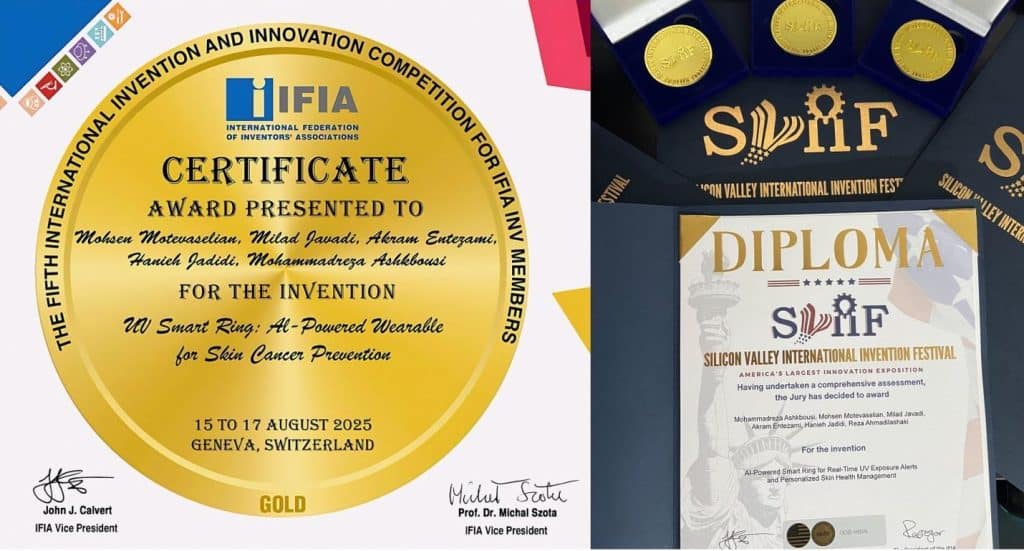Introduction
Dr. Mohsen Motevaselian is a radiologist, medical researcher, and inventor whose work exemplifies the convergence of clinical medicine, cutting-edge technology, and preventive healthcare. From his early education in Iran to his current involvement in international research projects, Dr. Motevaselian has consistently pursued innovation at the intersection of imaging science and patient-centered solutions.
His groundbreaking invention, a wearable smart ring designed to monitor ultraviolet (UV) exposure and physiological indicators, has earned him two gold medals in global invention competitions—including the prestigious Silicon Valley International Invention Expo and the Geneva International Exhibition of Inventions. The device leverages real-time data, artificial intelligence, and personalized analytics to predict the risk of skin cancer, offering proactive insights to users and embodying the principles of preventive medicine.
Parallel to his work in wearable technology, Dr. Motevaselian has made significant contributions to advanced radiology research, particularly in pediatric imaging and photon-counting CT (PCCT) studies. His approach combines large-scale data analysis, AI-driven diagnostics, and clinically informed evaluation, resulting in enhanced diagnostic accuracy and the processing of more than 650 pediatric patient scans—an unprecedented sample size in this emerging field.
Across his career, Dr. Motevaselian has emphasized the power of interdisciplinary collaboration, merging insights from engineering, computational analysis, and clinical medicine. His philosophy is guided by a simple yet profound principle: technology should not replace human expertise, but augment it, translating complex data into actionable knowledge that protects and improves lives.
Interview
Q: Can you describe how your journey in medicine and radiology began?
A: My journey started with medical studies in Iran, where I became fascinated by the invisible narratives that the body conveys through imaging. Radiology captured my imagination because it allowed us to “see” beyond what is immediately apparent, to interpret subtle signals that can change a patient’s life. From early on, I was interested not only in diagnosing but in anticipating and preventing disease. That curiosity naturally led me toward innovation, where I could combine medicine with engineering, data science, and artificial intelligence.
“Radiology taught me to read patterns that aren’t visible to the naked eye. That skill translated directly into developing predictive technologies like the smart ring.”
Q: What inspired the development of your wearable smart ring?
A: In clinical practice, I often saw patients with UV-related skin damage that could have been mitigated if detected earlier. I realized that by using real-time physiological monitoring, combined with environmental sensing, we could empower individuals to manage their own risk proactively. The ring integrates a UV sensor, pulse oximeter, and skin resistance sensor, feeding data into a mobile app powered by AI algorithms. The system then interprets these data points to provide personalized risk assessments and behavioral recommendations.
“Essentially, the ring applies radiology principles outside the clinic. It observes, analyzes, and delivers actionable insights, turning everyday exposure into a story that the user can act upon.”
Q: How do you connect your wearable technology with your radiology research?
A: While wearables and CT scanners might seem very different, both operate on the same core principles: data collection, pattern recognition, and predictive interpretation. In pediatric PCCT research, we analyze large volumes of imaging data to detect subtle biomarkers while reducing radiation exposure. Similarly, the smart ring interprets biometric and environmental signals to alert users about potential health risks.
“Whether it’s a CT scan or a wearable device, the mission is the same: detect invisible patterns early and use them to improve outcomes.”
Q: How does AI enhance your work in radiology and wearable technology?
A: AI serves as an amplifier of human expertise. It can process vast datasets, identify patterns that humans might miss, and deliver predictive insights. In radiology, AI helps identify anomalies and subtle biomarkers; in wearables, it enables real-time interpretation of physiological signals and lifestyle data.
“The future of healthcare lies in anticipatory medicine. AI, when used responsibly, allows us to detect issues before they become clinically apparent, fundamentally shifting healthcare from reactive to proactive.”
Q: You’ve received international recognition for your innovations. How has that shaped your perspective?
A: Winning gold medals in Silicon Valley and Geneva was an honor, but more importantly, it emphasized the universal relevance of practical innovation. It showed me that when science and technology intersect to serve humanity, ideas resonate globally, beyond cultural and geographic boundaries.
“Recognition is gratifying, but the real reward is knowing that these innovations can improve lives across the world.”
Q: Looking ahead, what excites you most about the future of radiology and health innovation?
A: The convergence of imaging, AI, and real-time monitoring excites me the most. We are entering an era where health interventions can be predictive and personalized. Radiology is evolving from interpretation of static images to integration of dynamic data streams, including lifestyle and physiological metrics.
Q: How do your experiences in global competitions influence your approach to innovation?
A: These experiences reinforced the importance of interdisciplinary and international collaboration. Innovation thrives when ideas, expertise, and cultural perspectives converge. Whether developing imaging techniques or wearable devices, collaboration accelerates progress and broadens impact.
“Science is universal. The most impactful work comes when we learn from multiple disciplines and multiple cultures.”
Q: What advice would you give to aspiring medical innovators?
A: Embrace curiosity and interdisciplinarity. Don’t limit yourself to a single field—major breakthroughs often occur at the intersection of disciplines. Learn from engineers, data scientists, and clinicians alike, and always focus on human impact. Technology has value only if it improves lives.
“If you anchor your work in empathy and human benefit, your innovations will not only succeed technically but transform lives.”
Conclusion
Dr. Mohsen Motevaselian embodies a new era of medical innovation where radiology, AI, and wearable technology intersect. His work demonstrates that the future of healthcare is proactive, personalized, and data-driven, yet always grounded in a human-centered philosophy. Through invention, research, and global collaboration, he continues to reshape how medicine interprets, predicts, and protects health, offering a vision of the future where individuals are empowered to act on insights before illness strikes.
